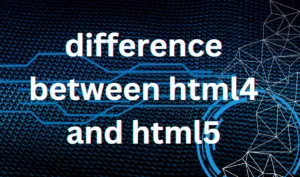difference between html4 and html5-HTML4 and HTML5 are both versions of the Hypertext Markup Language, which is used to structure content on the web. HTML5 is the newer and more advanced version compared to HTML4, bringing several improvements and new features. Here are some key differences between the two:
difference between html4 and html5
- Document Structure:
- HTML4: In HTML4, the document structure is based on a combination of HTML elements, CSS for styling, and JavaScript for interactivity.
- HTML5: HTML5 introduces new structural elements like
<header>,<nav>,<section>,<article>,<aside>, and<footer>. These elements provide a clearer and more semantic way to structure web content.
- Multimedia:
- HTML4: HTML4 lacks native support for multimedia. It relies on plugins like Adobe Flash to embed audio and video content.
- HTML5: HTML5 introduces the
<audio>and<video>elements, allowing native embedding of audio and video content without the need for plugins. This leads to better compatibility and performance.
- Canvas and Graphics:
- HTML4: HTML4 has limited support for graphics and requires external technologies for more advanced graphics.
- HTML5: HTML5 introduces the
<canvas>element, providing a powerful way to draw graphics, animations, and interactive content directly using JavaScript.
- Forms:
- HTML4: HTML4 forms are relatively basic and have limited input types.
- HTML5: HTML5 introduces new input types such as email, URL, date, and range, making it easier to create more advanced and user-friendly forms.
- Offline and Storage:
- HTML4: HTML4 lacks built-in support for offline browsing and client-side storage.
- HTML5: HTML5 introduces the Application Cache and Web Storage APIs, allowing websites to work offline and store data locally on the user’s device.
- Semantic Elements:
- HTML4: HTML4 focuses more on the presentational aspect of content.
- HTML5: HTML5 emphasizes semantic markup, meaning that elements are chosen based on their meaning and role in the content rather than just for styling. This enhances accessibility and search engine optimization.
- Compatibility:
- HTML4: HTML4 might lead to compatibility issues due to varying browser interpretations.
- HTML5: HTML5 was developed with better compatibility in mind, and major modern browsers support its features more consistently.
- APIs and Features:
- HTML4: HTML4 has limited APIs for advanced web features.
- HTML5: HTML5 introduces various new APIs, including Geolocation, Web Workers, WebSockets, and more, which enable richer and more interactive web applications.
difference between html4 and html5
In summary, HTML5 offers a more modern, feature-rich, and semantic way to structure web content compared to the older HTML4. Its enhancements in multimedia, graphics, forms, offline capabilities, and APIs have contributed to the evolution of web development and user experience.
